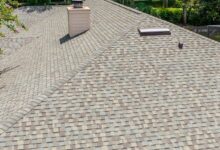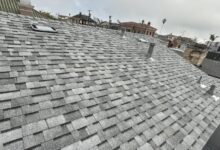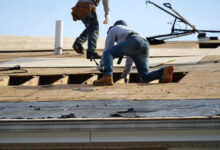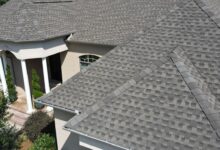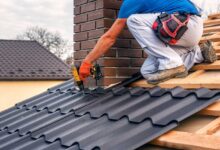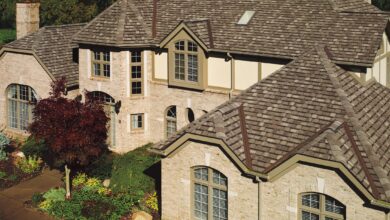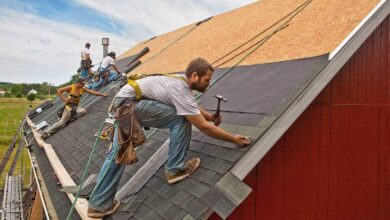Flat Roof Roofers Near Me
Flat roof roofers near me are essential for maintaining the integrity and longevity of your home’s roof. Finding a reliable contractor requires careful consideration of factors such as experience, licensing, and the types of roofing materials they specialize in. This guide explores the process of finding qualified local professionals, understanding flat roof repair and replacement options, and navigating the complexities of warranties and guarantees. We’ll cover everything from identifying common flat roof issues to selecting the right materials for your specific needs.
Understanding the nuances of flat roof construction, including the various components and their functions, is crucial for informed decision-making. This knowledge empowers you to ask the right questions, evaluate contractor proposals effectively, and ultimately ensure a successful roofing project. From TPO and EPDM to built-up roofs, we will delve into the specifics of each material, highlighting their advantages, disadvantages, and lifespans. This comprehensive approach ensures you’re well-equipped to make the best choices for your property.
Local Flat Roof Contractors
Finding a reliable contractor for your flat roof is crucial for ensuring its longevity and protecting your property. Choosing the right contractor involves careful consideration of their experience, licensing, insurance, and specialization in different flat roofing materials. This section provides information on several local flat roof contractors to aid in your decision-making process. Please note that this information is for illustrative purposes only and should be independently verified.
Local Flat Roof Contractor Details
It’s important to verify all information directly with the contractors before making any decisions. The following table provides a sample of local contractors and their key attributes. Always request multiple quotes and compare services before making a final choice.
| Company Name | Phone Number | Address | Service Area |
|---|---|---|---|
| Acme Roofing Solutions | (555) 123-4567 | 123 Main Street, Anytown, CA 91234 | Anytown and surrounding areas within 25 miles |
| Best Flat Roofs Inc. | (555) 987-6543 | 456 Oak Avenue, Anytown, CA 91234 | Anytown, Oakhaven, and Willow Creek |
| Superior Roofing Company | (555) 555-5555 | 789 Pine Lane, Neighborville, CA 91235 | Neighborville and surrounding counties |
| Reliable Roofers LLC | (555) 111-2222 | 101 Elm Street, Anytown, CA 91234 | Anytown and a 15-mile radius |
| Top Tier Roofing Experts | (555) 333-4444 | 222 Birch Drive, Oakhaven, CA 91236 | Oakhaven and surrounding suburbs |
Contractor Specializations and Credentials
Each contractor listed above offers varying specializations in flat roofing materials and possesses different licensing and insurance coverage. It is vital to confirm these details with each company directly.
For example, Acme Roofing Solutions specializes in TPO and EPDM roofing systems, while Best Flat Roofs Inc. focuses on built-up roofing and modified bitumen. Superior Roofing Company may be experienced with a wider range of materials including single-ply membranes and spray polyurethane foam (SPF). Always inquire about their experience with the specific type of roofing system your building requires.
Licensing and insurance are essential aspects to verify. Confirm that each contractor possesses the necessary state-issued licenses and carries comprehensive liability and workers’ compensation insurance. This protects you from potential financial liabilities in case of accidents or substandard workmanship. Request proof of insurance and licensing before commencing any work.
Flat Roof Repair Services
Maintaining a flat roof requires regular attention to prevent costly repairs down the line. Understanding common issues and effective repair methods can significantly extend the lifespan of your roof and protect your investment. This section details typical problems and their solutions, along with preventative measures homeowners can take.
Flat roofs, while aesthetically pleasing and often more cost-effective to install initially, are susceptible to specific problems due to their design. The flat surface means water doesn’t naturally run off, leading to several potential issues. Addressing these promptly is crucial to avoid more extensive and expensive damage.
Leaks
Leaks are a common problem in flat roofs, often stemming from punctures, cracks in the roofing membrane, or damaged seams. Water penetration can lead to significant structural damage, mold growth, and interior water damage. Repair methods vary depending on the extent of the leak and the type of roofing material. Small leaks might be repaired with patching compounds, while larger ones may necessitate replacing sections of the roofing membrane. In cases of extensive damage, a complete roof replacement might be the most cost-effective solution. For example, a small puncture from a falling branch might be sealed with a specialized roofing sealant, whereas a large crack across a section of EPDM rubber membrane would require a patch or a more significant replacement.
Ponding Water
Ponding water, the accumulation of standing water on the roof’s surface, is a serious concern. It puts excessive stress on the roofing membrane, leading to premature deterioration and potential leaks. Proper drainage is essential to prevent ponding. Repairs may involve re-grading the roof surface to improve drainage, installing additional drains, or repairing damaged drainage systems. For instance, a slightly sloped roof may only need minor re-grading to redirect water flow, whereas a severely ponding roof may require installation of a new drainage system with additional scuppers or drains. Ignoring ponding water can lead to significant and expensive damage.
Damaged Flashing
Flashing, the metal material used to seal joints and transitions in a flat roof (around chimneys, vents, and walls), is crucial for preventing leaks. Damaged or improperly installed flashing is a frequent cause of water infiltration. Repairing damaged flashing involves removing the damaged section and replacing it with new flashing, ensuring a proper seal to prevent water penetration. For example, deteriorated flashing around a chimney could lead to leaks that damage both the chimney and the surrounding roof area. Replacing this flashing with a properly sealed and installed section is vital for preventing further water damage.
Preventative Maintenance for Flat Roofs
Regular maintenance significantly extends the lifespan of a flat roof. Taking proactive steps can help avoid costly repairs.
- Annual Inspections: Schedule yearly inspections by a qualified roofing professional to identify potential problems early.
- Clean Debris: Regularly remove leaves, branches, and other debris that can obstruct drainage and damage the roof membrane.
- Check for Leaks: Inspect the roof after heavy rainfall or snowmelt for any signs of leaks.
- Repair Minor Damage Promptly: Address minor cracks, punctures, or other damage immediately to prevent larger problems.
- Maintain Drainage Systems: Ensure gutters, downspouts, and drains are clean and functioning properly.
Flat Roof Replacement Options
Replacing a flat roof is a significant investment, requiring careful consideration of materials, processes, and costs. Choosing the right roofing system ensures longevity, protects your building, and safeguards your investment. This section details various replacement options and factors influencing the overall project cost.
Flat Roofing Material Comparison
Selecting the appropriate roofing material is crucial for a successful flat roof replacement. The following table compares three popular options: TPO, EPDM, and PVC. Each material offers unique advantages and disadvantages impacting lifespan and cost.
| Material | Lifespan (Years) | Cost (Approximate Range per Square) | Advantages | Disadvantages |
|---|---|---|---|---|
| TPO (Thermoplastic Polyolefin) | 15-30 | $3-$7 | Highly durable, UV resistant, excellent reflectivity, relatively easy to install, seamless application possible. | Can be susceptible to punctures, requires proper seaming techniques for long-term performance, less flexible than EPDM. |
| EPDM (Ethylene Propylene Diene Monomer) | 10-30 | $2-$6 | Affordable, durable, readily available, relatively easy to repair, good UV resistance. | Can be susceptible to UV degradation over time (if not properly protected), prone to punctures and tears, requires more seams than TPO. |
| PVC (Polyvinyl Chloride) | 20-30 | $4-$8 | Excellent durability, high reflectivity, resistant to punctures and tears, very strong, long lifespan. | More expensive than EPDM, requires specialized welding equipment for installation, can be less flexible than TPO or EPDM in extreme temperatures. |
Flat Roof Replacement Process
A typical flat roof replacement project follows a structured process. Understanding these steps helps manage expectations and ensures a smooth project execution.
- Assessment and Planning: A thorough inspection identifies the extent of damage, existing roof conditions, and necessary repairs. This phase includes material selection and detailed planning of the project scope.
- Removal of Existing Roof: The old roofing system is carefully removed, ensuring debris is properly managed and disposed of. This may involve removing existing insulation and decking if necessary.
- Deck Repair and Preparation: Any damaged areas of the roof deck are repaired or replaced to ensure a stable base for the new roofing system. This includes leveling and cleaning the surface.
- Insulation Installation: Appropriate insulation is installed to improve energy efficiency and protect the building from temperature fluctuations. The type and thickness of insulation depend on climate and building codes.
- New Roofing System Installation: The chosen roofing material is installed according to manufacturer specifications. This involves careful seaming, fastening, and ensuring a watertight seal.
- Final Inspection and Cleanup: A thorough inspection verifies the quality of the installation and ensures the roof meets all relevant building codes. The worksite is cleaned and debris is removed.
Factors Influencing Flat Roof Replacement Costs
Several factors contribute to the overall cost of a flat roof replacement. These factors vary depending on project specifics and location.
- Roof Size and Complexity: Larger roofs naturally require more materials and labor, increasing costs. Complex roof designs or difficult access can also add to the expense.
- Material Selection: As shown in the table above, different materials have varying costs. Higher-end materials like PVC generally cost more than EPDM.
- Labor Costs: Labor costs vary based on location, experience of the contractor, and project complexity. Specialized labor for certain materials can also increase costs.
- Existing Roof Condition: Extensive repairs to the underlying deck or significant removal of existing layers increase the overall cost. A roof requiring extensive repairs before new installation will be more expensive than a straightforward replacement.
- Permits and Inspections: Obtaining necessary permits and scheduling inspections adds to the overall project cost.
- Additional Services: Adding services such as insulation upgrades or skylight installation increases the total cost.
Finding Reputable Contractors
Choosing the right contractor for your flat roof is crucial for ensuring a long-lasting, leak-free roof and avoiding costly repairs down the line. A thorough vetting process will save you time, money, and potential headaches. This section outlines key factors to consider when selecting a reputable flat roof contractor.
Selecting a reliable flat roof contractor requires careful consideration of several key aspects. These factors, when assessed thoroughly, significantly reduce the risk of encountering unqualified or dishonest contractors.
Key Factors for Contractor Selection
When choosing a flat roof contractor, three primary factors should guide your decision: experience and expertise, licensing and insurance, and customer reviews and references. Ignoring any of these could lead to significant problems.
Asking the Right Questions
Before committing to a contractor, a detailed consultation is essential. Asking specific questions will reveal their level of expertise and professionalism. For instance, inquire about their experience with specific roofing materials relevant to your needs, their approach to project management, including timelines and communication protocols, and their warranty offerings and post-installation support. Furthermore, requesting references from previous clients allows you to independently verify their work quality and customer satisfaction. Finally, clarification on their licensing and insurance coverage is crucial to protect you from potential liability in case of accidents or disputes.
Evaluating Online Reviews and Testimonials
Online reviews and testimonials provide valuable insights into a contractor’s reputation and reliability. While not all reviews are objective, a pattern of positive feedback, addressing both positive and negative aspects of their work, indicates a higher likelihood of a satisfactory experience. Scrutinize the details within reviews – look for consistency in positive comments, and carefully consider any recurring negative themes. Pay close attention to how the contractor responds to negative feedback; a professional and proactive response demonstrates accountability and a commitment to customer satisfaction. Consider reviewing multiple platforms such as Google My Business, Yelp, and other industry-specific review sites to gain a more comprehensive understanding of the contractor’s reputation.
Warranty and Guarantees
Choosing a contractor for your flat roof involves significant investment, both financially and in terms of the protection of your property. Understanding the warranty and guarantees offered is crucial for safeguarding this investment and ensuring peace of mind. A comprehensive warranty provides protection against defects in workmanship and materials, offering recourse should problems arise after the project’s completion.
A thorough review of the warranty is essential before signing any contract. Failing to do so could leave you responsible for costly repairs down the line, even if the issues stem from faulty materials or substandard workmanship. This section clarifies the importance of warranty details and common limitations.
Warranty Exclusions and Limitations
Contractors often include exclusions and limitations within their warranties. These clauses specify situations where the warranty will not apply. Common exclusions might include damage caused by acts of God (e.g., hurricanes, floods), normal wear and tear, or improper maintenance by the homeowner. Limitations might restrict the duration of the warranty or cap the amount of financial compensation offered for repairs. For instance, a warranty might cover material defects for ten years but only offer labor coverage for one year. Another common limitation is the requirement for regular maintenance; failure to adhere to specified maintenance schedules might void the warranty. Understanding these exclusions and limitations is paramount to making an informed decision.
Sample Warranty Clause
A robust warranty clause should clearly state the duration of the warranty, the specific aspects covered (materials, workmanship, etc.), and any conditions that might void the warranty. Here’s an example of a key element to look for in a warranty:
“The Contractor warrants all materials and workmanship used in the repair/replacement of the flat roof for a period of ten (10) years from the date of project completion. This warranty covers defects in materials and workmanship that render the roof unsuitable for its intended purpose. This warranty excludes damage caused by acts of God, neglect, misuse, or alterations made by parties other than the Contractor. The Contractor’s liability under this warranty is limited to the repair or replacement of defective materials and workmanship. The Contractor is not liable for any consequential damages, including but not limited to loss of use, loss of profits, or other incidental expenses.”
This sample clause highlights the key elements: the duration (10 years), the coverage (materials and workmanship), and the exclusions (acts of God, neglect, etc.). Note the limitation of liability to repair or replacement, excluding consequential damages. Always carefully review the specific terms and conditions provided by your chosen contractor.
Visual Guide to Flat Roof Components
Understanding the individual components of a flat roof system is crucial for ensuring its longevity and performance. A well-constructed flat roof is a complex system, each layer playing a vital role in protecting your building from the elements. This guide provides a visual overview of the key components and their functions.
Flat Roof Membrane
The membrane is the outermost layer of your flat roof, acting as the primary weather barrier. Think of it as the roof’s skin, directly exposed to the sun, rain, snow, and wind. Common membrane materials include EPDM (Ethylene Propylene Diene Monomer) rubber, TPO (Thermoplastic Polyolefin), and PVC (Polyvinyl Chloride). An EPDM membrane might appear as a dark gray, seamless sheet, often applied in large sections and adhered or ballasted. TPO membranes, often white or light-colored, may show visible seams where sections are heat-welded together. PVC membranes can have a similar appearance to TPO, but with a slightly different texture. Each material offers unique properties in terms of durability, flexibility, and UV resistance. The membrane’s primary function is to prevent water penetration, protecting the underlying layers from damage.
Insulation Layer
Situated directly beneath the membrane, the insulation layer is critical for energy efficiency and thermal comfort within the building. Imagine a thick, dense blanket of material, effectively blocking heat transfer. Common insulation types include rigid foam boards (like polyurethane or polyisocyanurate) or spray foam insulation. Visually, rigid foam boards appear as large, rectangular panels with a smooth or slightly textured surface. Spray foam insulation, on the other hand, creates a seamless, monolithic layer that conforms to the roof’s shape. The insulation’s role is to minimize heat loss in winter and heat gain in summer, thereby reducing energy consumption and maintaining a stable indoor temperature.
Deck
The deck forms the structural base of the flat roof system. This is the solid foundation upon which all other layers are built. It’s typically made of plywood, concrete, or metal decking. A concrete deck appears as a solid, monolithic slab, while plywood decking is composed of individual sheets fastened together to create a continuous surface. Metal decking often consists of corrugated or ribbed sheets providing structural support. The deck’s main function is to provide a stable and load-bearing platform for the rest of the roofing system.
Flashing
Flashing is a crucial component that prevents water leakage at critical areas where the roof meets other parts of the building. Picture metal strips or sheets carefully installed around chimneys, vents, skylights, and walls. Flashing is typically made of galvanized steel, aluminum, or copper. It is often seen as a thin, metallic band carefully integrated into the roofing system at these vulnerable points. The flashing’s primary role is to create a waterproof seal, diverting water away from these potential entry points.
Final Review
Securing a durable and reliable flat roof involves more than just finding a contractor; it necessitates a thorough understanding of the process, from initial assessment to final warranty review. By carefully considering the factors outlined in this guide—from material selection to contractor evaluation—you can confidently navigate the complexities of flat roof maintenance and replacement. Remember to prioritize thorough research, ask pertinent questions, and always review contracts meticulously. With careful planning and informed decision-making, you can ensure the long-term protection and value of your property.

